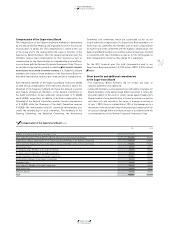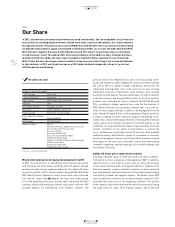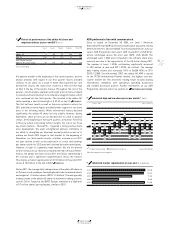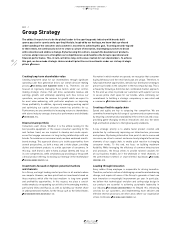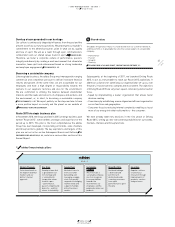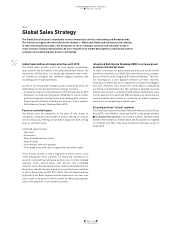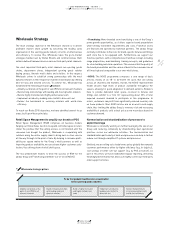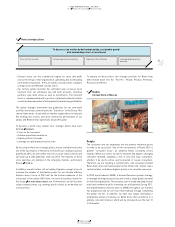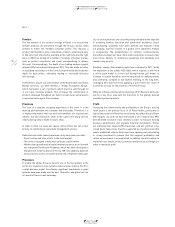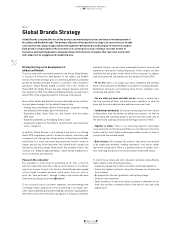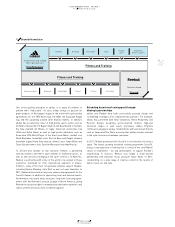Reebok 2011 Annual Report Download - page 67
Download and view the complete annual report
Please find page 67 of the 2011 Reebok annual report below. You can navigate through the pages in the report by either clicking on the pages listed below, or by using the keyword search tool below to find specific information within the annual report.
adidas Group
2011 Annual Report
GROUP MANAGEMENT REPORT – OUR GROUP
63
2011
02.2 Global Sales Strategy Wholesale Strategy
Wholesale Strategy
The main strategic objective of the Wholesale channel is to deliver
profitable market share growth by becoming the leading sales
organisation in the sporting goods industry in terms of effectiveness
and efficiency. To realise this, Wholesale takes the go-to-market
strategies handed over by Global Brands and commercialises them
within a defined framework across various third-party retail channels.
Our most important third-party retail channels are sporting goods
chains, department stores, independent sporting goods retailer
buying groups, lifestyle retail chains and e-tailers. In this respect,
Wholesale strives to establish strong partnerships with the most
dynamic retailers in their respective channel of distribution by offering
best-in-class and tailored services. To achieve this, Wholesale has
established the following principles
DIAGRAM 01
:
– Amplify our brands at the point of sale (POS) in all relevant channels
– Build strong relationships with leading and most dynamic retailers
– Build a highly motivated and highly skilled sales team
– Implement an industry-leading sales toolkit to drive sell-out
– Deliver the benchmark in servicing retailers with world-class
efficiency
To reach our Route 2015 objectives, we have identified several focus
areas, built upon these principles.
Retail Space Management to amplify our brands at POS
Retail Space Management (RSM) comprises all business models
helping our Global Sales function to expand controlled space in retail.
Under the premise that the selling process is not finished until the
consumer has bought the product, Wholesale is cooperating with
retailers along the entire supply chain to bring best-in-class service
all the way through to the point of sale. By helping to increase profit-
ability per square metre for the Group’s retail partners as well as
improving product availability, we can achieve higher customer satis-
faction, thus driving share of retail shelf space.
The two predominant models to drive the success of RSM for the
adidas Group are Franchising and Never-out-of-stock (NOOS).
– Franchising: Mono-branded store franchising is one of the Group’s
prime growth opportunities, as it offers superior brand presentation
while limiting investment requirements and costs. Franchise stores
are financed and operated by franchise partners. The adidas Group
normally contributes to the costs for brand-specific fixtures and fittings
each store has to be equipped with. Furthermore, we support our
franchise partners with a comprehensive franchise concept, including
range propositions, merchandising, training concepts, and guidelines
for store building and store operations. This ensures that the quality of
the brand presentation and the service offered to the consumer are at
all times high and comparable to our own-retail stores.
− NOOS: The NOOS programme comprises a core range of basic
articles, mostly on an 18- to 24-month life cycle, that are selling
across all channels and markets. Overall, the NOOS replenishment
model secures high levels of product availability throughout the
season, allowing for quick adaptation to demand patterns. Retailers
have to provide dedicated retail space, co-invest in fixtures and
fittings and commit to a “first fill” representing about 25% of total
expected seasonal demand to participate in this programme. In
return, customers can profit from significantly reduced inventory risk
on these products. Most NOOS articles are on an end-to-end supply
chain, thus limiting the adidas Group’s inventory risk and increasing
availability of products sold at best price as we re-produce based on
customer demand.
Harmonisation and standardisation of processes to
exploit leverage
Wholesale is constantly working on further leveraging the size of our
Group and reducing complexity by implementing best operational
practices across our wholesale activities. The harmonisation and
standardisation particularly of back-end processes can help to further
reduce cost through simplified IT systems and processes.
Similarly, we are rolling out a trade terms policy globally that rewards
customer performance either by higher efficiency (e.g. in logistics),
cost savings or better sell-out support (e.g. by POS activation). As
part of this effort, we have established regular reporting, delivering
meaningful benchmarks that allow us to tightly control our third-party
retail support activities.
01 Wholesale strategic pillars
Amplify our brands at the
point of sale (POS) in all
relevant channels
Build strong relationships
with leading and most
dynamic retailers
Build a highly motivated
and highly skilled sales
team
Implement an industry-
leading sales toolkit to
drive sell-out
Deliver the benchmark
in servicing retailers with
world-class efficiency
To be the globally leading sales organisation
in the sporting goods industry


